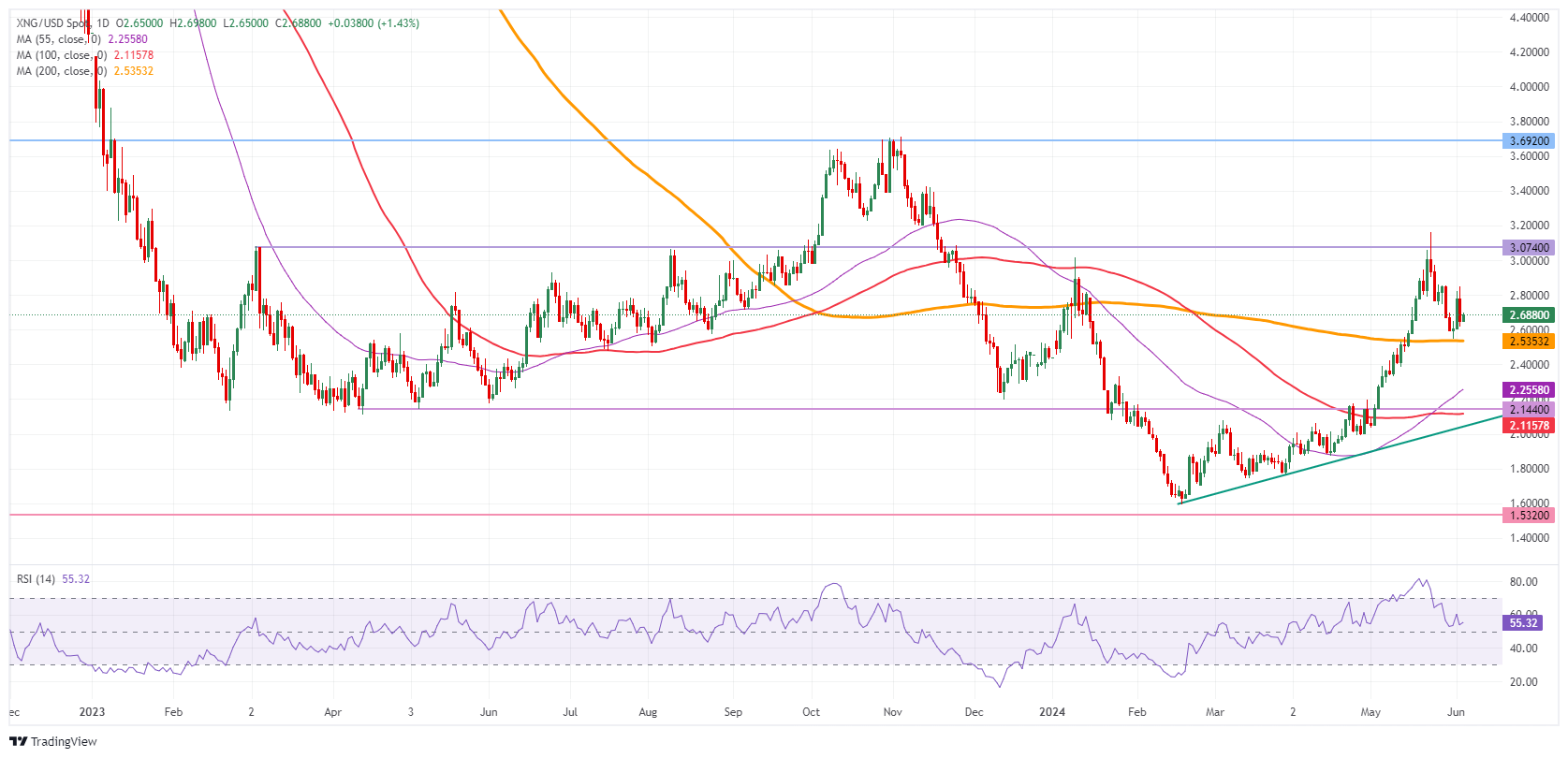Natural Gas consolidates with May rally abrupt ending and Europe’s reserves in good position for coming winter

- Natural Gas price consolidate this week after a sharp rally in May.
- Egypte is importing more Gas ahead of the summer session to meet energy demand.
- The US Dollar Index jumps higher on Tuesday and is on track to recover initial weekly losses.
Natural Gas price (XNG/USD) trades roughly flat at around $2.70 during the European trading session on Wednesday. The price action is starting to turn choppy with market participants starting to unwind their overextended long positions in Natural Gas via options and futures contracts. The main driver for the unwind is the European gas storage reserve, which has broken above 70% for the first time since last winter.
Meanwhile, the US Dollar Index (DXY), which tracks the Greenback’s value against six major currencies, moves higher for a second straight day of gains after Monday’s decline. For the week, the DXY index still trades in a loss, ahead of the ADP private payroll number and the Institute for Supply Management’s (ISM) Services Purchasing Managers Index (PMI) data for May scheduled on Wednesday.
Natural Gas is trading at $2.66 per MMBtu at the time of writing.
Natural Gas news and market movers: Europe in good position for winter 2024
- As mentioned above, European overall Gas storage reserves are back above 70%, according to Bloomberg data.
- Egypt will import around 20 additional Liquefied Natural Gas (LNG) cargoes this summer to meet energy demand during the hottest period of the year. Gas Exports out of Egypt are still banned, Reuters reports.
- According to port data, demand for LNG is set to fall in June as both Asia and Europe take fewer deliveries than last month. Bloomberg Energy reports that global LNG imports will fall by 3% this month compared to May data.
Natural Gas Technical Analysis: Breakout due at any moment
Natural Gas is trading back in the middle of the range that is starting to form between $2.60 and $2.82. This consolidation is more than welcome after the wild and steep ride in May. With some profit-taking and reassessments taking place, some additional retracement might be welcomed first before investors start to buy in again.
The $3.00 marker as a big figure was tested in May. The pivotal level near $3.07 ( March 6, 2023, high) remains key as prices failed to post a daily close above it. Further up, the fresh year-to-date high at $3.16 is the level to beat.
On the downside, the 200-day Simple Moving Average (SMA) acts as the first support near $2.53. Should that support area fail to hold, the next target could be the pivotal level near $2.14, with interim support by the 55-day SMA near $2.25. Further down, the biggest support comes at $2.11 with the 100-day SMA.
Natural Gas: Daily Chart
Natural Gas FAQs
Supply and demand dynamics are a key factor influencing Natural Gas prices, and are themselves influenced by global economic growth, industrial activity, population growth, production levels, and inventories. The weather impacts Natural Gas prices because more Gas is used during cold winters and hot summers for heating and cooling. Competition from other energy sources impacts prices as consumers may switch to cheaper sources. Geopolitical events are factors as exemplified by the war in Ukraine. Government policies relating to extraction, transportation, and environmental issues also impact prices.
The main economic release influencing Natural Gas prices is the weekly inventory bulletin from the Energy Information Administration (EIA), a US government agency that produces US gas market data. The EIA Gas bulletin usually comes out on Thursday at 14:30 GMT, a day after the EIA publishes its weekly Oil bulletin. Economic data from large consumers of Natural Gas can impact supply and demand, the largest of which include China, Germany and Japan. Natural Gas is primarily priced and traded in US Dollars, thus economic releases impacting the US Dollar are also factors.
The US Dollar is the world’s reserve currency and most commodities, including Natural Gas are priced and traded on international markets in US Dollars. As such, the value of the US Dollar is a factor in the price of Natural Gas, because if the Dollar strengthens it means less Dollars are required to buy the same volume of Gas (the price falls), and vice versa if USD strengthens.
